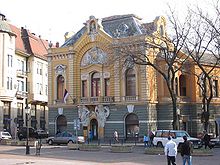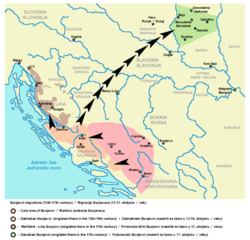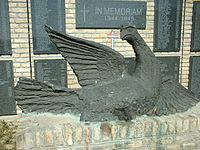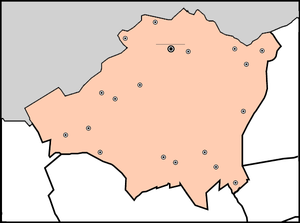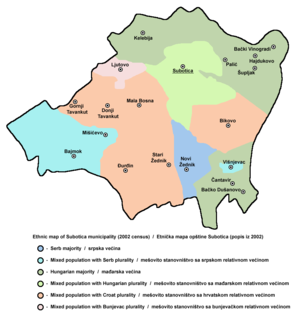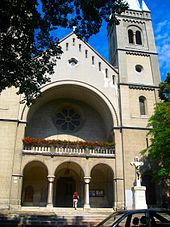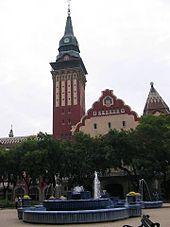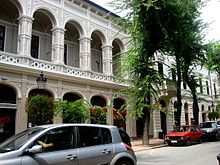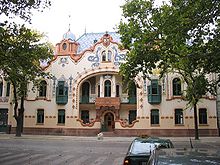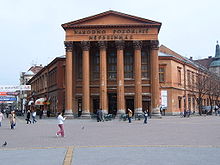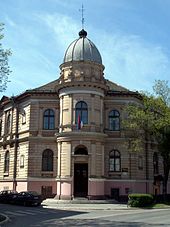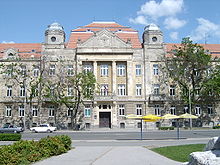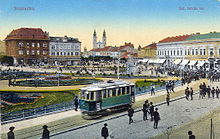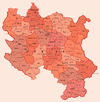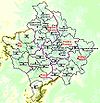- Subotica
-
For other uses, see Subotica (disambiguation).
Subotica
Суботица
SzabadkaSubotica City Hall square 
Flag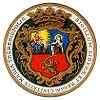
Coat of armsLocation of Subotica within Serbia Coordinates: 46°06′01″N 19°39′56″E / 46.10028°N 19.66556°ECoordinates: 46°06′01″N 19°39′56″E / 46.10028°N 19.66556°E Country  Serbia
SerbiaProvince  Vojvodina
VojvodinaDistrict North Bačka Settlements 19 Government - Mayor Saša Vučinić (DS) Area - Land 1,008 km2 (389.2 sq mi) Population (2002)[1] - City 148,401 - Urban 99,981 Time zone CET (UTC+1) - Summer (DST) CEST (UTC+2) Postal code 24000 Area code(s) (+381) 24 Car plates SU Website www.subotica.rs Subotica (Serbian Cyrillic: Суботица [sǔbɔtit͡sa] (
 listen), Hungarian: Szabadka, Bunjevac: Subotica, Croatian: Subotica) is a city and municipality in northern Serbia, in the Autonomous Province of Vojvodina. It is located at 46.07° North, 19.68° East, about 10 km from the border with Hungary.
listen), Hungarian: Szabadka, Bunjevac: Subotica, Croatian: Subotica) is a city and municipality in northern Serbia, in the Autonomous Province of Vojvodina. It is located at 46.07° North, 19.68° East, about 10 km from the border with Hungary.Formerly the largest city of Vojvodina region, contemporary Subotica is now the second largest city in the province, following Novi Sad. It is also the fifth largest city in Serbia (discounting Kosovo) after Belgrade, Novi Sad, Niš, and Kragujevac. It is a multiethnic city, with Hungarians (34.99%), Serbs (27.85%), Bunjevci (10.87%) and Croats (10.43%) as largest ethnic groups. The city's population numbers 99,981 (according to the 2002 census). Linguistically the city has a South Slavic-speaking majority as Serbs, Croats, Bunjevci and Yugoslavs collectively compose 55.94% of the population. The municipality of Subotica numbers 148,401 people. It is the administrative centre of the North Bačka District.
Contents
Name
There have been almost two hundred different forms of the name of this city in history. This is because the city has welcomed so many different peoples since the Middle Ages. They all wrote about it, naming it in their own languages, which, for some, did not fix their spelling until modern times.
The earliest known written name of the city was Zabadka or Zabatka,[2] which dates from 1391. This is a variant of the current Hungarian name for the city: Szabadka. The Hungarian name for the city derives from the adjective szabad meaning "free", and the suffix -ka, an affectionate diminutive. Subotica's earliest designation means, therefore, something like a "small" or "dear", "free place". According to other opinion, medieval name Zabatka could derive from South Slavic word "zabat", which describe parts of Pannonian Slavic houses.[3]
The name Subotica derives from the Serbian / Bunjevac word for "Saturday" or "Sabbath" and first appeared in 1653. The Serbian / Bunjevac word for "Saturday" is subota (субота), thus the name Subotica means "a little Saturday". Another theory claims that city was named after Subota Vrlić, who was a palatine and treasurer of a Emperor Jovan Nenad, which ruled from this city in the 16th century. An older Serbian name used for the city in the 16th century was Sabatka, while Ottoman Turkish name was Sobotka.
The town was renamed in the 1740s for Maria Theresa of Austria, Archduchess of Austria and Queen of Bohemia and Hungary. The town was officially called Sent-Maria in 1743, but was renamed in 1779 as Maria-Theresiapolis. These two official names were also spelled in several different ways (most commonly the German Maria-Theresiopel or Theresiopel), and were used in different languages. This name was abandoned in 1811 (with the Danube Swabians now referring to it mostly as Subotica, and pronouncing it Suboditsa).[citation needed] However a late-19th Century Imperial Land Survey map of the area (Reymann 1:75000 #5563) still shows it as Maria-Theresiopel.
The city's name in the other three official languages of Vojvodina are the same as the official name - Slovak: Subotica, Rusyn: Суботица, Romanian: Subotica or Subotiţa.
History
Prehistory
A Neolithic Tiszapolgár-Bodrogkeresztúr culture necropolis was found in Subotica.[4]
The Middle Ages
Subotica probably first became a settlement of note when people poured into it from nearby villages destroyed during the Tatar invasions of 1241-1242. When Zabadka / Zabatka was first recorded in 1391, it was a tiny town in the medieval Kingdom of Hungary. Later, the city belonged to the Hunyadis, one of the most influential aristocratic families in the whole of Central Europe.
King Matthias Corvinus of Hungary gave the town to one of his relatives, János Pongrác Dengelegi, who, fearing an invasion by the Ottoman Empire fortified the castle of Subotica, erecting a fortress in 1470. Some decades later, after the Battle of Mohács in 1526, the medieval Kingdom of Hungary collapsed and Subotica gradually became a town of the Ottoman Empire. The majority of the Hungarian population fled northward to Royal Hungary. Bálint Török, a local noble who had ruled over Subotica, also escaped from the city.
In the extremely confused military and political situation following the defeat at Mohács, Subotica came under the control of Serbian mercenaries recruited in Banat. These soldiers were in the service of the Transylvanian general John I Zápolya, a later Hungarian king. The leader of these mercenaries, Jovan Nenad the Black, proclaimed himself tsar and founded an ephemeral independent state, with Subotica as its capital. This state comprised entire Bačka, northern Banat and a small part of Srem. When Bálint Török returned with 300 soldier and captured Subotica from the Serbs, Jovan Nenad moved his capital to Szeged.[5] Some months later, in the summer of 1527, the self-proclaimed tsar was assassinated and his state collapsed.
Ottoman administration
The Ottoman Empire ruled the city from 1542 to 1686. At the end of this almost 150 year long period, not much remained of the old town of Zabadka / Zabatka. Because much of the population had fled, the Ottomans encouraged the settlement of the area by different colonists from the Balkans. The settlers were mostly Orthodox Serbs. They cultivated the extremely fertile land around Subotica. In 1570, the population of Subotica numbered 49 houses, and in 1590, 63 houses. In 1687, the region was settled by Catholic Dalmatas (called Bunjevci today). It was called "Sobotka" during Ottoman rule and was a kaza centre in Segedin sanjak at first in Budin Eyaleti till 1596, and after that in Eğri Eyaleti between 1596-1686.[6]
Habsburg administration
In 1687, about 5,000 Bunjevci, led by Dujo Marković and Đuro Vidaković settled in Bačka (including Subotica). After the decisive battle against the Ottomans at Senta (Zenta) led by Prince Eugene of Savoy on 11 September 1697, Subotica became part of the military border zone Theiss-Mieresch established by the Habsburg Monarchy. In the meantime the uprising of Francis II Rákóczi broke out, which is also known as the Kuruc War. In the region of Subotica, Rákóczi joined battle against the Rac National Militia. Rác was a designation for the South Slavic people (mostly Serbs and Bunjevci) and they often were referred to as rácok in the Kingdom of Hungary. In a later period rácok came to mean, above all, Serbs of Orthodox religion.
The Serbian military families enjoyed several privileges thanks to their service for the Habsburg Monarchy. Subotica gradually, however, developed from being a mere garrison town to becoming a market town with its own civil charter in 1743. When this happened, many Serbs complained about the loss of their privileges. The majority left the town in protest and some of them founded a new settlement just outside 18th century Subotica in Aleksandrovo, while others emigrated to Russia. In New Serbia, a new Russian province established for them, those Serbs founded a new settlement and also named it Subotica. In 1775 a Jewish community in Subotica was established.
It was perhaps to emphasise the new civic serenity of Subotica that the pious name Saint Mary came to be used for it at this time. Some decades later, in 1779, Empress Maria Theresa of Austria advanced the town's status further by proclaiming it a Free Royal Town. The enthusiastic inhabitants of the city renamed Subotica once more as Maria-Theresiopolis.
This Free Royal Town status gave a great impetus to the development of the city. During the 19th century its population doubled twice, attracting many people from all over the Habsburg Monarchy. This led eventually to a considerable demographic change. In the first half of the 19th century, the Bunjevci had still been in the majority, but there was an increasing number of Hungarians and Jews settling in Subotica. This process was not stopped even by the outbreak of the Revolutions in the Habsburg Monarchy in 1848/49.
1848/1849 Revolutions
It is remarkable that despite the diversity of their ethnic origins, the citizens of Subotica (mainly Bunjevci and Hungarians) united in defending Subotica in the battle at Kaponya, March 5, 1849. They repulsed the advancing Serbian troops from Sombor in the direction to Szeged. The town's first newspaper was also a result of the 1848/49 revolutionary spirit. It was called Honunk állapota ("State of Our Homeland") and was published in Hungarian by Károly Bitterman's local printing company. Unlike most Serbs and Croats who confronted with Hungarians, local Bunjevci people mostly supported Hungarian revolution.
In 1849, following the suppression of the Hungarian Revolution, Subotica, together with most of the Bačka region, was separated from the Habsburg Kingdom of Hungary and became a part of a separate Austrian province, named Voivodeship of Serbia and Banat of Temeschwar. The administrative centre of this new province was not Subotica, but Timişoara. This province existed until 1860. During the existence of the voivodeship, in 1853, Subotica acquired its impressive theatre.
Austro-Hungarian administration
After the establishment of the Dual-Monarchy in 1867, there followed what is often called the "golden age" of city development of Subotica. Many schools were opened after 1867 and in 1869 the railway connected the city to the world. In 1896 an electrical power plant was built, further enhancing the development of the city and the whole region. Subotica now adorned itself with its remarkable Central European, fin de siècle architecture. In 1902 a Jewish synagogue was built in the Art Nouveau style.
South Slavic states
Subotica was part of the Austria-Hungary until the aftermath of World War I in 1918, when the city became part of the Kingdom of Serbs, Croats and Slovenes. In changed economical and political circumstances, Subotica was now a border-town in Yugoslavia and did not, for a time, experienced again the dynamic prosperity it enjoyed in the years preceding World War I. However, at that time, Subotica was the third largest city in Yugoslavia by population, following Belgrade and Zagreb.
In 1941, Yugoslavia was invaded and partitioned by the Axis Powers, and its northern parts, including Subotica, were annexed by Hungary (This partition of Yugoslavia was not recognized by the international community and city was, from the legal point of view, still part of Yugoslavia, whose only legal representative was Yugoslav government in exile). Hungarian troops entered Subotica on April 11, 1941. During World War II the city lost approximately 7,000 of its citizens, mostly Serbs, Hungarians and Jews.[citation needed] Before the war about 6,000 Jews lived in Subotica. Many Jews were deported from the city during the Holocaust, mostly to Auschwitz. In April 1944 a ghetto was set up. Also, many communists were put to death during Axis rule. In 1944, the Axis forces left city, and Subotica became part of the new socialist Yugoslavia. During the 1944-45 period about 8,000 citizens (mainly Hungarian) were killed by Yugoslav partisans.[7][8]
In the post-war period Subotica has gradually modernised itself. During the Yugoslav and Kosovo wars of the 1990s, a considerable number of Serb refugees came to the city from Croatia, Bosnia and Herzegovina, and Kosovo, whilst many ethnic Hungarians and Croats left the country because of the political pressures of the Milošević period and economical stagnation (Some of the ethnic Serb residents also left the country because of the same reasons[citation needed]). During the break-up of Yugoslavia, local leaders in Subotica were drawn from political parties opposed to the policy of the state government in Belgrade.
Towns and villages
SuboticaVišnjevacThe Subotica municipality comprises the Subotica city, the town of Palić and 17 villages. The villages are:
- Bajmok
- Bački Vinogradi (Hungarian: Bácsszőlős)
- Bačko Dušanovo (Hungarian: Zentaörs)
- Bikovo
- Višnjevac
- Gornji Tavankut
- Donji Tavankut
- Đurđin
- Kelebija (Hungarian: Kelebia)
- Ljutovo
- Mala Bosna
- Mišićevo
- Novi Žednik
- Stari Žednik
- Hajdukovo (Hungarian: Hajdújárás)
- Čantavir (Hungarian: Csantavér)
- Šupljak (Hungarian: Ludas)
Note: For settlements with Hungarian absolute or relative majority, names are also given in Hungarian.
City quarters
- Prozivka
- Ker
- Centar 1
- Centar 2
- Dudova Šuma (Radijalac)
- Železničko Naselje
- Novo Naselje (Hungarian: Újtelep)
- Srpski Šor (Hungarian: Szerb sor)
- Zorka
- Kertvaroš (Hungarian: Kertváros)
- Makova Sedmica
- Novi Grad
- Mali Radanovac
- Teslino Naselje
- Veliki Radanovac
- Aleksandrovo
- Mali Bajmok (Hungarian: Kisbajmok)
- Gat (Hungarian: Gát)
- Graničar
- Centar 3 (Tokio)
- Bajnat
Demographics
City demographics - Ethnic groups in the city
Subotica is a multiethnic city and municipality. The population of the Subotica city is composed of (according to 2002 census):
- Hungarians = 34,983 (34.99%)
- Serbs = 27,838 (27.85%)
- Bunjevci = 10,870 (10.87%)
- Croats = 10,424 (10.43%)
- Yugoslavs = 6,787 (6.79%)
- Roma = 1,171 (1.17%)
- others
The city serves as the cultural and political centre for the Hungarians, Bunjevci, and Croats in Vojvodina. The largest percent of declared Yugoslavs in Vojvodina is also found in Subotica.
Municipality demographics
Ethnic groups in the municipality
The population of the Subotica municipality is composed of (according to 2002 census):
- Hungarians = 57,092 (38.47%)
- Serbs = 37,686 (25.39%)
- Croats = 16,688 (11.24%)
- Bunjevci = 16,254 (10.95%)
- Yugoslavs = 8,562 (5.76%)
- others
Settlements by ethnic majority
The places with a Hungarian absolute or relative ethnic majority are: Subotica (Hungarian: Szabadka), Palić (Hungarian: Palicsfürdő), Hajdukovo (Hungarian: Hajdújárás), Bački Vinogradi (Hungarian: Bácsszőlős), Šupljak (Hungarian: Alsóludas), Čantavir (Hungarian: Csantavér), Bačko Dušanovo (Hungarian: Zentaörs), and Kelebija (Hungarian: Alsókelebia).
The places with a Serb absolute or relative ethnic majority are: Bajmok, Višnjevac, Novi Žednik, and Mišićevo.
The places with a Bunjevac and Croat ethnic majority are: Mala Bosna, Đurđin, Donji Tavankut, Gornji Tavankut, Bikovo, Stari Žednik, and Ljutovo.
Bajmok, Višnjevac, and Stari Žednik have over 20% Hungarians, just as in the places with a Hungarian majority (Subotica, Palić, Bačko Dušanovo, and Kelebija) in which over 20% are Serbs, Croats and Bunjevci.
Languages in the municipality
Languages spoken in Subotica municipality (according to 2002 census):
Note: The Bunjevac language is also spoken in Subotica, but it was not listed separately in the 2002 census results published by the Statistical Office of Serbia; the speakers of this language were listed in category "other languages". The number of those who speak "other languages" (presumably Bunjevac[citation needed]) in the Subotica municipality is 8,914. [1]PDF (441 KiB) Some other members of the Bunjevac ethnic community declared in census that their language is Serbian or Croatian. Bunjevac is likely to be listed separately in the future censa, since the members of the Bunjevac ethnic community expressed the wish for affirmation of their language. They also expressed the wish to have school classes in Bunjevac, so the state is most likely to oblige.
Religion
Religion in Subotica municipality (according to 2002 census):
- Roman Catholic = 93,521 (63.02%)
- Orthodox = 38,523 (25.96%)
- Protestant = 2,794 (1.88%)
- other
Subotica is the centre of the Roman Catholic diocese of the Bačka region belonging to Serbia. The Subotica area has the highest concentration of Catholics in Serbia. Nearly 70% of the city's population are Catholics. The liturgical languages used in the city's Catholic churches are mostly Hungarian and Croatian. There are eight Catholic parish churches, a Franciscan spiritual centre (the city has communities of both Franciscan monks and Franciscan nuns), a female Dominican community, and two congregations of Augustinian religious sisters. The diocese of Subotica has the only Catholic secondary school in Serbia (Paulinum).
Subotica had a Roman Catholic Blessed working in it. When the nuns' orphanage and children's dome in Blato has exhausted the food funds for helping poor and hungry children, Blessed Mary of Jesus Crucified Petković went to fertile pleains of Bačka and the seat of Bačka Apostolic Administration, Subotica, to solicit help for the orphans and widows. In return, Bishop Ljudevit Lajčo Budanović asked her to found monasteries of her Order in Subotica and neighbourhood, so the locals can get spiritual gain from that nuns of her Order can provide them...[9] Marija Petković quickly notice that Bačka also had problems of numerous poor and abandoned children, so in 1923, she opened Kolijevka, Children's Home in Subotica. Today this city still has that Children's Home, although the nuns of Marija's Order aren't in that Home anymore.
Among another Christian communities, the members of the Serbian Orthodox Church are the most numerous. There are two Eastern Orthodox church buildings in the city; as well as two Protestant churches, Lutheran and Calvinist, respectively.
The Jewish community of Subotica is the third largest in Serbia, after those in Belgrade and Novi Sad. The astounding proportions and beauty of the Hungarian style art nouveau synagogue are the legacy of a Jewish community that once numbered 6,000 members. About 1,000 of the original Jews of Subotica survived the Holocaust. Today, less than 200 people of Jewish origin remained in Subotica.
Politics
2004 elections
Seats in the municipal parliament won in the 2004 local elections: [2]
- Alliance of Vojvodina Hungarians (16)
- Democratic Party (12)
- Serbian Radical Party (9)
- Democratic Alliance of Croats in Vojvodina (5)
- G17 Plus (4)
- Together for Vojvodina (4)
- Democratic Party of Vojvodina Hungarians (3)
- Serbian Strength Movement (3)
2008 elections
Results of 2008 local elections in Subotica municipality: [3]
- For a European Subotica (40.16%)
- Hungarian Coalition (27.14%)
- Serbian list for Subotica (16.42%)
After the elections, coalition For a European Subotica (with 32 seats), Hungarian Coalition (with 21 seats) and Bunjevac Party (with 1 seat) formed local municipal government. Saša Vučinić from the Democratic Party was elected mayor, and Jenő Maglai from the Hungarian Coalition was elected president of the municipal assembly. [4]
Buildings
Unique in Serbia, Subotica has the most buildings built in art nouveau style. Especially the City Hall (built in 1908-1910) and the Synagogue (1902) are of outstanding beauty. These were built by the same architects, by Marcell Komor and Dezső Jakab from Budapest, Hungary. Another exceptional example of art nouveau architecture is the actual Artistic Encounter building, which was built in 1904 by Ferenc J. Raichle.
The most remarkable church buildings are: the Catholic Cathedral of St. Theresa of Avila from 1797, the Franciscan Monastery from 1723, the Orthodox churches also from the 18th century, the Hungarian Art Nouveau Subotica Synagogue from the turn-of-the-century.
In recent years there has been an effort to restore the synagogue. Over $400,000 has been raised for the cause by 2004.
Theatre
The historic National Theatre in Subotica, which was built in 1854 as the first monumental public building in Subotica, was demolished in 2007, although it was declared a historic monument under state protection in 1983, and in 1991 it was added to the National Register as a monument of an extraordinary cultural value[citation needed]. An international campaign was organized both in Serbia and in Hungary to save the historic building. ICOMOS and INTBAU also protested against the decision, but with no avail. The historic centre of Subotica was severely damaged visually. Some scanty remains of the destroyed building will be allegedly incorporated into the new theatre.[10]
Education
Subotica is not a university city but has some widely respected secondary schools and faculties.
Secondary Schools
- Teachers' College, founded in 1689, the oldest college in the country and region
- "Svetozar Marković" grammar school web-site
- "Dezső Kosztolányi" Philological grammar school web-site
- "Paulinum" Grammar school of ancient languages of the Catholic Diocese of Subotica
- Music School
- "MEŠC" Electro-mechanical school, recently renamed to "Tehnička Škola - Subotica" (en. "Technical School") web-site
- "Bosa Milićević" School of Economics
- Polytechnic school
- "Lazar Neśić" Chemistry school
- Medical school
Notable faculties
- Civil Engineering faculty web-site
- Electro-Mechanic-Programming faculty "VTŠ" web-site
- Economics faculty web-site
- Teachers faculty in Hungarian language web-site
- Kindergarten Teacher Training College web-site
Newspapers and magazines
Newspapers and magazines published in Subotica:
- Subotičke novine, main weekly newspaper in Serbian (web-site).
- Magyar Szó, in Hungarian, founded 1944, published in Subotica since 2006.
- Bunjevačke novine, in Bunjevac.
- Hrvatska riječ, in Croatian.
- Zvonik, in Croatian
Economy
Surroundings of Subotica are mainly farmland but the city itself is an important industrial and transportation centre in Serbia.
Because of the surrounding farmlands Subotica has some of the most famous food producer industries in the country, with brands such as the confectionery factory "Pionir", "Fidelinka" the cereal manufacturer, "Suboticka mlekara" a milk producer and "Simex" producer of strong alcohol drinks.
There are a number of old socialistic industries that survived the transition period in Serbia.The biggest one is the chemical fertilizer factory "Azotara" and the rail wagon factory "Bratstvo".
Currently the biggest export industry in town is the "Siemens Subotica" windmill factory and it is the biggest brownfield investment so far. The other big companies in Subotica are: Fornetti, ATB Sever and Masterplast.
The most recent companies to come to Subotica are Dunkermotoren, and NORMA Group.
The main reason why foreign industry is usually interested in Subotica are (according to the local economic development office (web-site)):
- Perfect strategic location for business development
- Efficient and business friendly administration
- Free zone and logistic center
- Well trained, hardworking and easy to come by labour
- Great tourist recognition
The city received the NALED award for being the one of five best cities in Serbia for investors in 2010 and also has the NALED business-friendly certificate.[11]
Tourism is significantly important to the city due to Palić and the Palić Lake being near by, which is by itself a tourist destination. In the past few years, Palić has been famous for the Palić Film Festival.
Subotica is also a festival city, hosting more than 17 festivals over the year. (web-site)
Transportation
The Subotica tram, put into operation in 1897, ran on electricity from the start. While neighbouring cities' trams at this date were often still horse-drawn, this gave the Subotica system an advantage over municipalities including Belgrade, Novi Sad, Zagreb, and Segedin. Its existence was important to the citizens of Subotica, as well as tourists who came to visit. Subotica has a bus system. The Subotica buses transport people via nine city, six suburban, and ten interurban, as well as two international lines of bus operations. Per year the buses pass some 4.7 million kilometers, and carry about ten million people.[12] The city used to have a tram system, the Subotica tram system, but it was discontinued in 1974.
Communication
Southwest of Subotica at 46°04′30.97″N 19°37′45.01″E / 46.0752694°N 19.6291694°E, there is a 218.5 metres tall guyed mast for FM-/TV-broadcasting. It may be the tallest of its kind in Serbia.
Famous citizens
- György Arnold (1771–1848), composer
- Sava Babić (b. 1934), writer, translator and university professor
- József Bártfay (1812–1864), lawyer, writer
- Géza Csáth (1887–1919), a tragic physician-writer
- Gyula Cseszneky (b. 1914), poet, voivode
- Sreten Damjanović (b. 1946), wrestler
- Oliver Dulić (b. 1975), politician
- Vlatko Dulić (b. 1943), actor
- Dr. Kalmar Elemer (1887–1947), lawyer
- Yehuda Elkana, b.1934. Israeli philosopher of science
- Pierre Jovanović (b. 1960), French writer and reporter
- Zoran Kalinić (b. 1958), table tennis champion
- Danilo Kiš (1935–1989), possibly the most well-known Serbian writer alongside the Nobel laureate Ivo Andrić
- Juci Komlós (b. 1919), actress
- Dezső Kosztolányi (1885–1936), Hungarian poet and prose-writer
- Félix Lajkó (b. 1974), a "world music" violinist and composer
- Péter Lékó (b. 1979), Hungary's number one chess player
- Szilveszter Lévai (b. 1945), Hungarian composer
- Aleksandar Lifka (1880–1952), a central-European cinematographer
- Bela Lugosi (1882–1956), actor
- Bruck Matija (Bruk Matjas), chemist, creator of Kosan
- Refik Memišević (b. 1956), wrestle champion
- Gyula Mester, born in 1972, volleyball player
- Jovan Mikić Spartak (1914–1944), the leader of the Partisans in Subotica, and a national hero who was killed in 1944
- Dr. Vinko Perčić (1911–1989), authority in gastroenterology and internal medicine
- Momir Petković (b. 1953), wrestle champion
- Bojana Radulović (b. 1973), handball player
- Eva Ras (b. 1941), actress, painter and Serbian writer
- Magdolna Rúzsa (b. 1985), Hungarian pop singer
- Ivan Sarić (1876–1966), aviation pioneer and cyclist
- Tibor Sekelj (Tibor Székely) (1912–1988), explorer, esperantist, writer
- John Simon, American theatre critic
- Đuro Stantić (1878–1918), a world champion in racewalking
International cooperation
- Subotica is a pilot city of the Council of Europe and the EU Intercultural cities programme.[13]
Twin towns - Sister cities
Subotica is twinned with the following cities:
Partner Cities
Subotica is a partner city with the following:
 Turku, Finland
Turku, Finland Ulm, Germany
Ulm, Germany Wolverhampton, United Kingdom
Wolverhampton, United Kingdom Zagreb, Croatia
Zagreb, Croatia Zirc, Hungary
Zirc, Hungary
See also
- List of mayors of Subotica
- List of cities in Serbia
- Intercultural cities
References
- ^ (in Serbian) Popis stanovništva, domaćinstava i Stanova 2002. Knjiga 1: Nacionalna ili etnička pripadnost po naseljima. Statistical Office of the Republic of Serbia. 2003. ISBN 86-84443-00-09.
- ^ http://www.discoverserbia.org/en/backa/subotica
- ^ http://webcache.googleusercontent.com/search?q=cache:UXHnb5gDziEJ:bunjevci.com/novine/pdf/bunjevacke/2006_08.pdf+segedinski+sandzak&cd=23&hl=en&ct=clnk
- ^ http://www.rastko.rs/arheologija/ntasic-eneolit.html
- ^ Borovszky Samu: Magyarország vármegyéi és városai, Bács-Bodrog vármegye I.-II. kötet, Apolló Irodalmi és Nyomdai Részvénytársaság, 1909.
- ^ http://en.wikipedia.org/wiki/Sanjak_of_Segedin
- ^ Mészáros Sándor: Holttá nyilvánítva - Délvidéki magyar fátum 1944-45., I.-II., Hatodik Síp Alapítvány, Budapest 1995.
- ^ Cseres Tibor: Vérbosszú Bácskában, Magvető kiadó, Budapest 1991.
- ^ (Croatian) Bl. Marija Petković M. Stantić: Zauzimanje za siromahe - karizma danas
- ^ Viktorija Aladzic (2007). "The Old Theatre of Subotica Demolished". INTBAU.org. http://www.intbau.org/newsarchive2007.htm. Retrieved 30 March 2008.
- ^ http://www.naled-serbia.org/index.php
- ^ http://www.danas.rs/vesti/srbija/vojvodina/tramvaji_prvo_u_subotici_pa_u_beogradu.41.html?news_id=123629&action=print
- ^ Council of Europe (2011 [last update]). "Intercultural city: Subotica, Serbia". coe.int. http://www.coe.int/t/dg4/cultureheritage/culture/Cities/subotica_en.asp. Retrieved 22 May 2011.
- Recent (2002) statistical information comes from the Serbian statistical office.
- Ethnic statistics: КОНАЧНИ РЕЗУЛТАТИ ПОПИСА 2002PDF (477 KiB), САОПШTЕЊЕ СН31, брoј 295 • год. LII, 24.12.2002, YU ISSN 0353–9555. Accessed 17 Jan 2006. On page 6–7, Становништво према националној или етничкој припадности по попису 2002. Statistics can be found on the lines for "Суботица" (Subotica).
- Language and religion statistics: Popis stanovništva, domaćinstava i stanova u 2002, ISBN 86-84433-02-5. Accessed 17 Jan 2006. On page 11–12: СТАНОВНИШТВО ПРЕМА ВЕРОИСПОВЕСТИ, СТАНОВНИШТВО ПРЕМА МАТЕРЊЕМ ЈЕЗИКУ. Statistics can be found on the lines for "Суботица" (Subotica).
External links
- The official website of Subotica
- JP Subotica Trans - Public Transport Official Site
- Subotica.com - Most popular Website of Subotica
- GradSubotica.co.rs - News from the city
- The official website of the Roman Catholic diocese of Subotica
- Subotica's official website for tourism and travel information
- Subotica on Wikitravel
- History of Subotica
- Panoramic pictures from Subotica
- Medija Centar Subotica - (najnovije vesti) News from Subotica
Cities, towns and villages in the North Bačka District Subotica: Bajmok • Bački Vinogradi • Bačko Dušanovo • Bikovo • Višnjevac • Gornji Tavankut • Donji Tavankut • Đurđin • Kelebija • Ljutovo • Mala Bosna • Mišićevo • Novi Žednik • Palić • Stari Žednik • Hajdukovo • Čantavir • Šupljak
Bačka Topola: Bagremovo • Bajša • Bački Sokolac • Bogaraš • Gornja Rogatica • Gunaroš • Zobnatica • Kavilo • Karađorđevo • Krivaja • Mali Beograd • Mićunovo • Novo Orahovo • Njegoševo • Obornjača • Tomislavci • Panonija • Pačir • Pobeda • Svetićevo • Srednji Salaš • Stara Moravica
(*) bold are municipalities
Historical capitals of Serbia 641–950 Destinikon
950–1276 Ras1430–1453 Smederevo
1526–1527 Subotica1818–1841 Kragujevac
1849–1860 Temišvar
1914–1915 Kragujevac
1915 NišCategories:- Former capitals of Serbia
- Subotica
- Places in Bačka
- Populated places in Vojvodina
- Municipalities of Vojvodina
Wikimedia Foundation. 2010.




